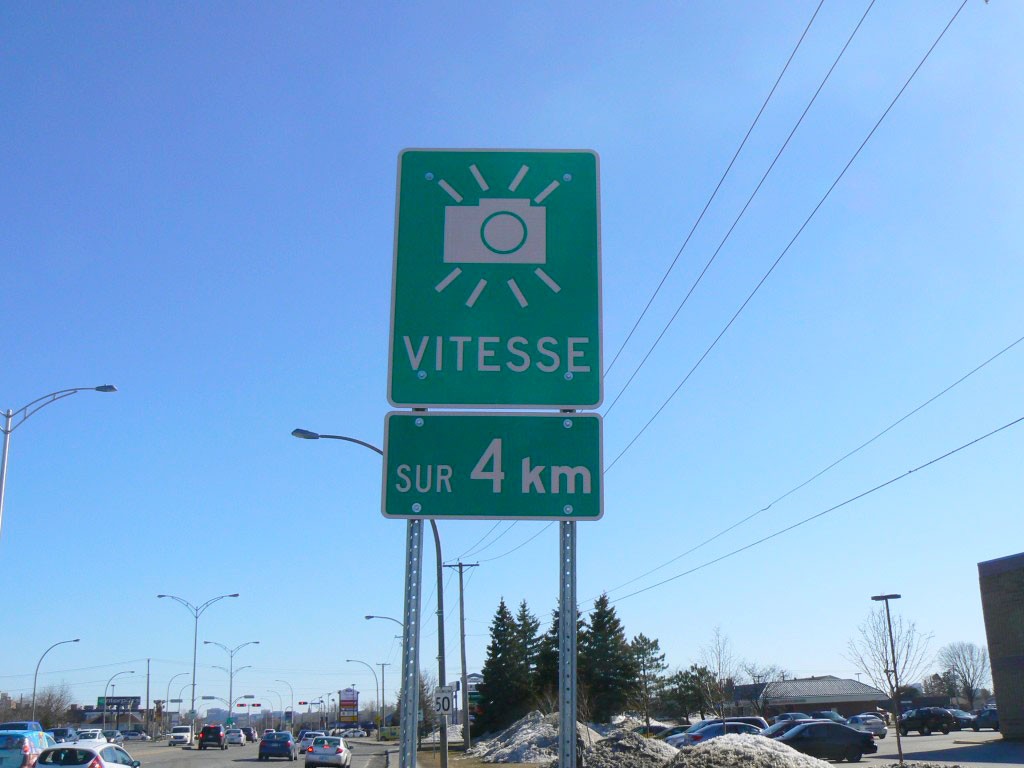Photo radar to catch speeders: Ottawa considers it, Quebec already has it
Okay, we’ve all driven over the speed limit before, and some of us have even been caught for it. I got my first speeding ticket was when I was 20. I was driving a brand-new, borrowed Mercedes-Benz home from church one Sunday and got caught going 80 kilometres per hour (50 MPH) in a 50 kilometre per hour (30 MPH) zone. The city police constable, whose name tag humorously read “R. Sheriff,” rounded it down and I got away with a $35.00 fine.
Ottawa City Council has been discussing lately if it should introduce photo radar for speed enforcement on city roads. A petition has been gathering signatures in support of photo radar, and a councilor wants it to deal with speeding traffic in their ward. However, if Ottawa, or any other Ontario city wants photo radar, they’ll have to get permission from the Ontario government first.

Curbside Kodak: A sign marks the beginning of a four kilometre photo radar zone on Greber Boulevard in Gatineau, Quebec. Photo by James Morgan
Supporters of photo radar say it’s a great way to enforce speed limits and reduce dangerous driving. Critics say it’s just another way for the city to generate revenue.
Ontario has been through this experience before. In 1994, the government of then-Premier Bob Rae introduced photo radar on several provincial highways. Gray minivans with a camera and radar device attached, supervised by a lone Ontario Provincial Police officer, were situated along shoulders or behind bridge piers. Unsuspecting speeders would have their speed clocked on radar and a photo taken of their rear license plate. A few days later, the ticket would show up in the vehicle owner’s mailbox.
Photo radar became a political issue. The economy was bad, the government needed revenue badly. Mike Harris, leader of the Progressive Conservatives lambasted photo radar as nothing but a “cash cow” and promised to get rid of it if he became Premier. The promise helped Harris win the 1995 election and photo radar was scrapped soon after. However, photo radar cameras that catch drivers running red lights have since appeared in many Ontario cities, including Ottawa.
Quebec started using photo radar in 2009, mostly in the Montreal region. In October 2015, the city of Gatineau launched an 18-month pilot project to bring the curbside candid cameras to town. City police identified 21 locations across the city where speed is an issue. Signs showing a clicking camera and VITESSE—French for speed—started going up on major routes throughout Gatineau. Unlike with Ontario’s photo radar experience 20 years ago, Gatineau is being a bit more open with its methods. Traffic signs in photo radar zones indicate the distance for which drivers can expect photo radar enforcement, and a traffic sign always indicates the end or FIN of the photo radar zone. And, a mobile sign is always placed next to the unmarked white police van containing the radar and camera equipment. In my experience, these warnings often result in many drivers slamming on their brakes, hoping they’ve avoided an unpleasant surprise in the mail. The city also lists all of the photo radar zones on its website.
It still isn’t clear if Gatineau will keep photo radar once the pilot project period is over. The Quebec Department of Transport however said photo radar in some form or another is here to stay, insisting the program is strictly for speed enforcement and not for padding government revenue.
Aside from the debate over whether photo radar is an effective enforcement tool or just a money grab, the issue raises other questions. If police forces are allegedly short on funds and human resources, why create more work for them by assigning officers to photo radar detail? The red-light cameras in many cities are automated, stationary units. Could photo radar equipment be installed the same way? That option would allow police officers to spend more time on other public safety priorities. Even if photo radar is not intended to be a way of increasing city revenue, is there a risk that city officials will start to rely on it as a revenue source? Enforcing speed and traffic safety is important, but should it become a way of extending the city budget beyond what taxes and fees can fund?
Ottawa City Council will revisit the photo radar debate in early May.
Tags: canada, Gatineau, Ontario, ottawa, police, Quebec, speeding, traffic safety







